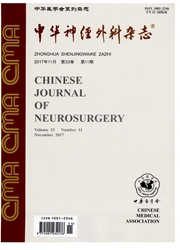

 中文摘要:
中文摘要:
目的观察温度敏感型干细胞联合亚低温在缺氧环境中的生长和增殖情况。方法建立一种温度敏感型干细胞株,BrdU标记;体内研究通过建立液压冲击重型颅脑创伤模型、移植温敏干细胞和亚低温治疗,采用免疫组织化学检测损伤近缘BrdU的表达水平;体外研究通过低氧培养或低营养低熔点凝胶培养模型,调整培养箱温度(33℃或37℃),进行细胞计数,免疫细胞荧光检测PCNA或caspase3的表达;采用Westernblot检测体内和体外HIF-1α的表达水平。结果移植第7天,温敏干细胞联合亚低温组损伤近缘的BrdU阳性数量显著增多(P〈0.01);低氧培养中,亚低温处理组较非处理组的细胞数量和PCNA表达明显增加,而亚低温联合温敏干细胞组的细胞数量和PCNA表达增加最为显著(P〈0.01);低营养培养环境中,亚低温处理组较非处理组的caspase3表达明显减少,而亚低温联合温敏干细胞组的caspase3表达减少最为显著(P〈0.01);体内和体外Westernblot结果显示亚低温联合干细胞组HIF-1α表达显著增加(P〈0.01)。结论温敏干细胞联合亚低温治疗可增加移植干细胞抵抗TBI后缺氧微环境的能力和提高移植干细胞的存活率,可为TBI后干细胞移植提供新且更为有效的方案。
 英文摘要:
英文摘要:
Objective To investigate the effect of combinational hypothermia on growth and proliferation of temperature sensitive stem cells in hypoxia microenvironment after traumatic brain injury (TBI). Methods Temperature sensitive human umbilical cord mesenchymal stem cell line (tsUCMSCs) was generated and labeled by BrdU. In vivo study, severe traumatic brain injury mice model was established by fluid percussion. Then, PBS, UCMSCs or tsUCMSCs was implanted into injured region, and normothermia or mild hypothermia therapy (33℃) was adopt. The expression of BrdU in post - injury area was examined by immunohistochemistry. In vitro study, hypoxia or low serum in low metling agarose gel model was used, by which UCMSCs or tsUCMSCs in 33℃ or 37℃ was cuhured. Cell number was counted with hematocytometer and PCNA or caspase 3 was measured with immunofluoreeent staining. The level of hypoxia - inducible factor -1αHIF -1α) in vitro and in vivo was examined by western blot. Results The BrdU- positive cells in post - injury area at 7d of transplantation were significantly increased in combinational tsUCMSCs and hypothermia group. Compared with cells in 37℃ , cells in 33℃ showed more cell number, more PCNA and less caspase 3 expression in hypoxia or low serum culture condition, among of which tsUCMSCs in 33℃ group showed the most enhancement of cell number and PCNA or the most decrease of caspase 3. The level of HIF -1α was elevated both in vitro and in vivo model. Conclusion Combination of tsUCMSCs and hypothermia could increase the ability of grafted stem cells adapting to the hypoxia microenvironment and facilitate more survival of transplanted stem cells after TBI. This combinational therapy may provide a new and feasible strategy for TBI.
 同期刊论文项目
同期刊论文项目
 同项目期刊论文
同项目期刊论文
 期刊信息
期刊信息
